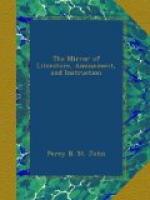In the courtyard is shown a stone, on which is engraved a cross and divers figures, said to allude to the murder of Malcolm, and the death of the murderers, who attempting to cross the Lake of Forfar, then slightly frozen over, the ice broke, and they were drowned: this stone is described and engraved by Mr. Pennant, in his Tour through Scotland.
By way of enlivening these historical data, and as an epigrammatic conclusion to our description, we subjoin a pleasant little anecdote related by Sir Walter Scott, of a certain old Earl of Strathmore, who, in superintending some improvements of the castle, displayed an eccentric love of uniformity. “The earl and his gardener directed all in the garden and pleasure-grounds upon the ancient principle of exact correspondence between the different parts, so that each alley had its brother—a principle now renounced by gardeners. It chanced once upon a time that a fellow was caught committing some petty theft, and, being taken in the manner, was sentenced by the Bailie M’Wheeble of the jurisdiction to stand for a certain time in the baronial pillory, called the jougs, being a collar and chain attached to the uppermost portal of the great avenue which led to the castle. The thief was turned over accordingly to the gardener as the ground officer, to see the punishment duly inflicted. When the Thane of Glammis returned from his morning ride, he was surprised to find both sides of the gateway accommodated each with a prisoner. He asked the gardener, whom he found watching the place of punishment, as his duty required, whether another delinquent had been detected? ‘No, my lord,’ said the gardener, in the tone of a man excellently well satisfied with himself, ’but I thought the single fellow looked very awkward standing on one side of the gateway, so I gave half-a-crown to one of the labourers to stand on the other side for uniformity’s sake.’”
* * * * *
ON LOCALITIES:
Literary recollections of London.
(To the Editor of the Mirror.)




